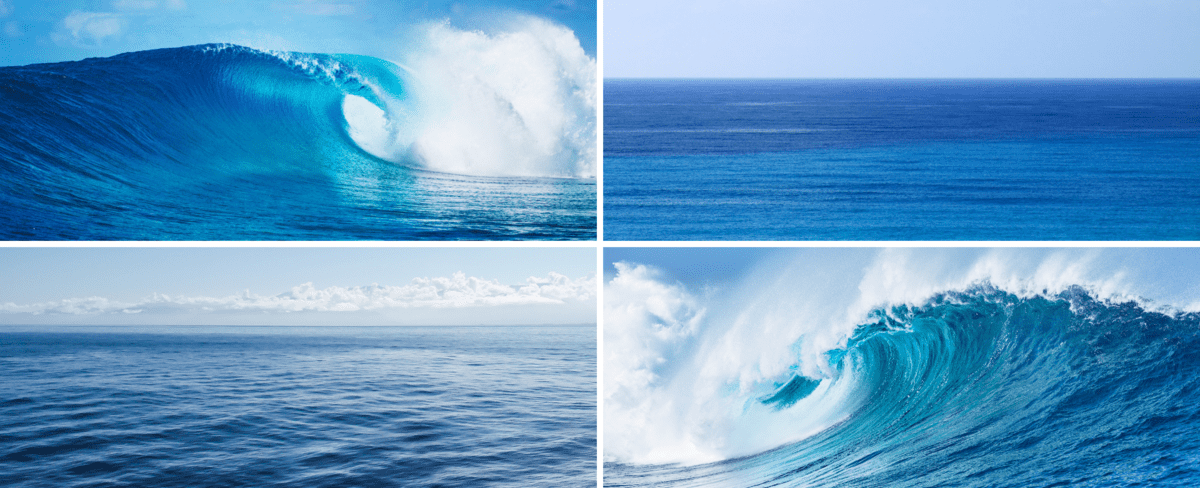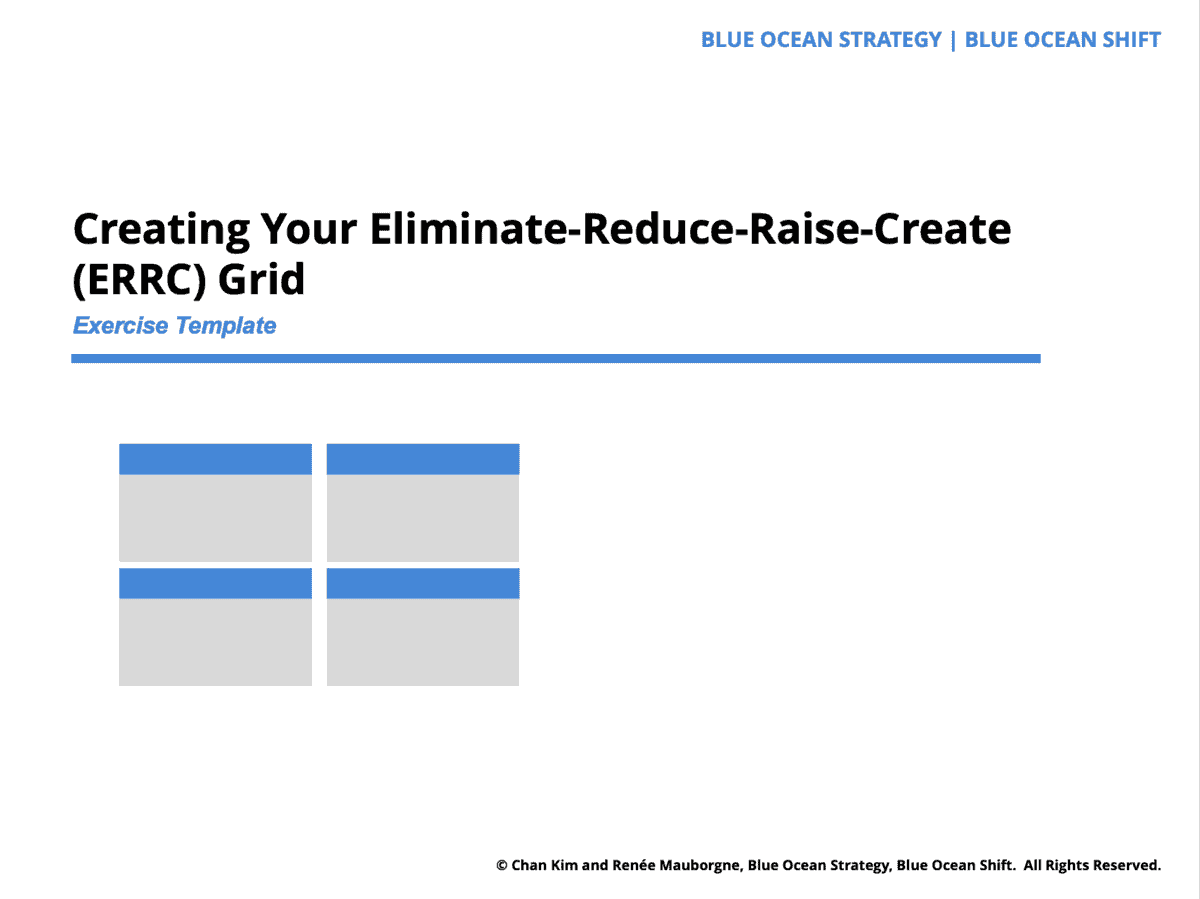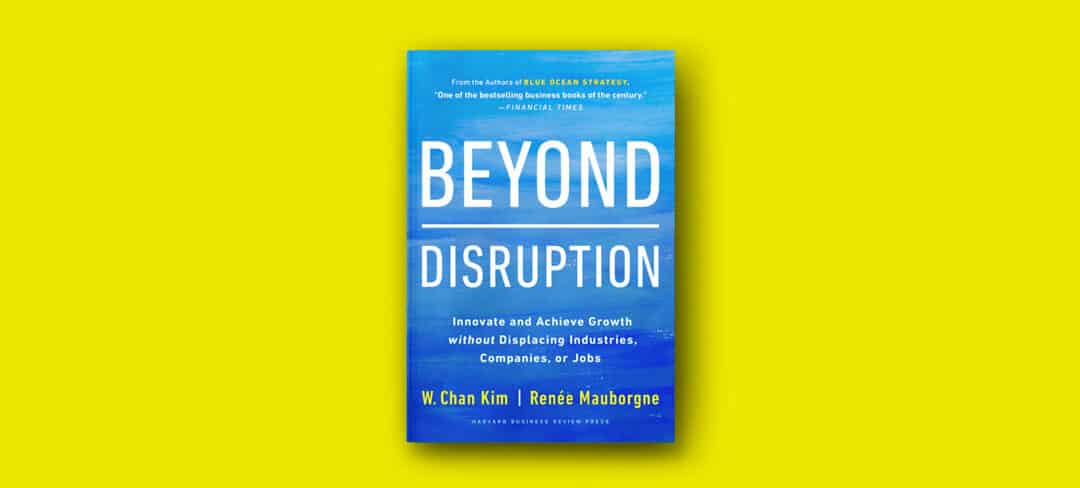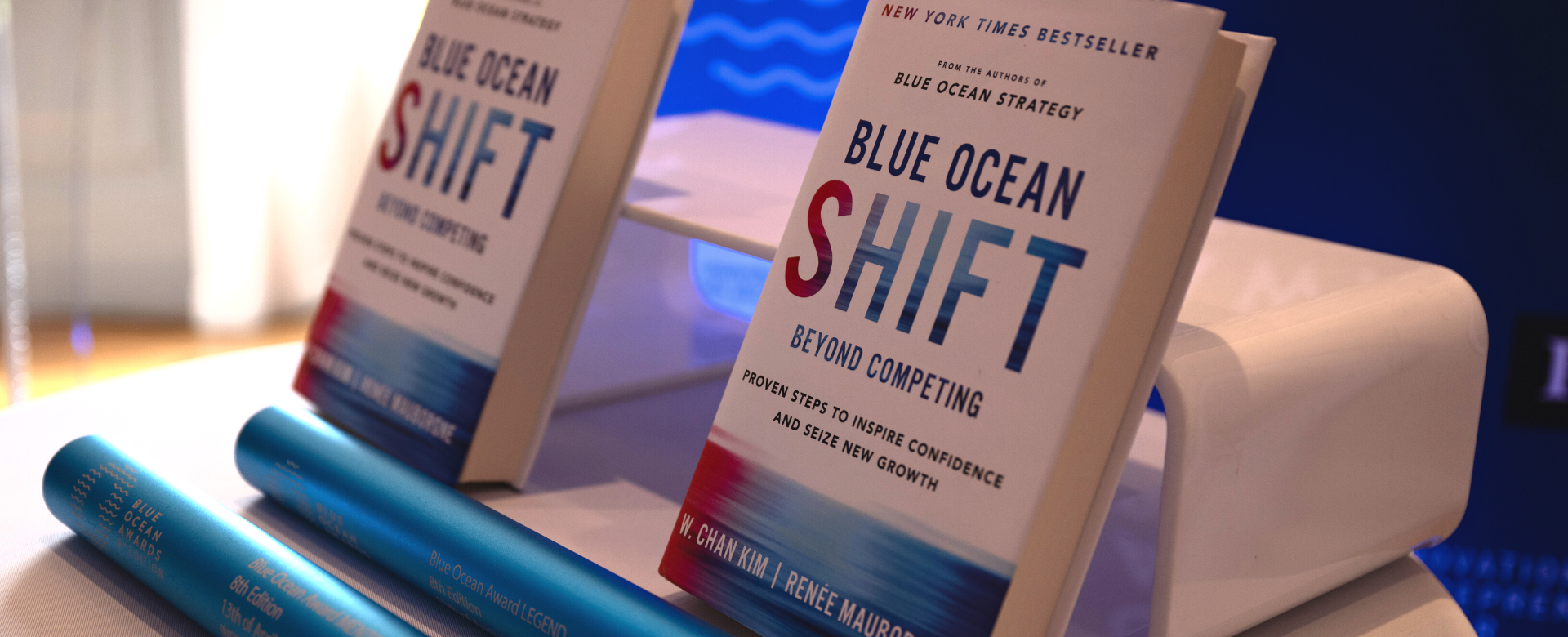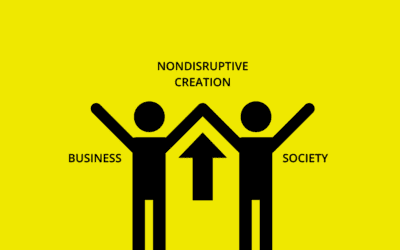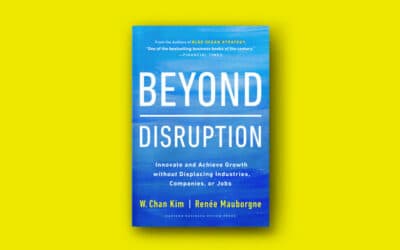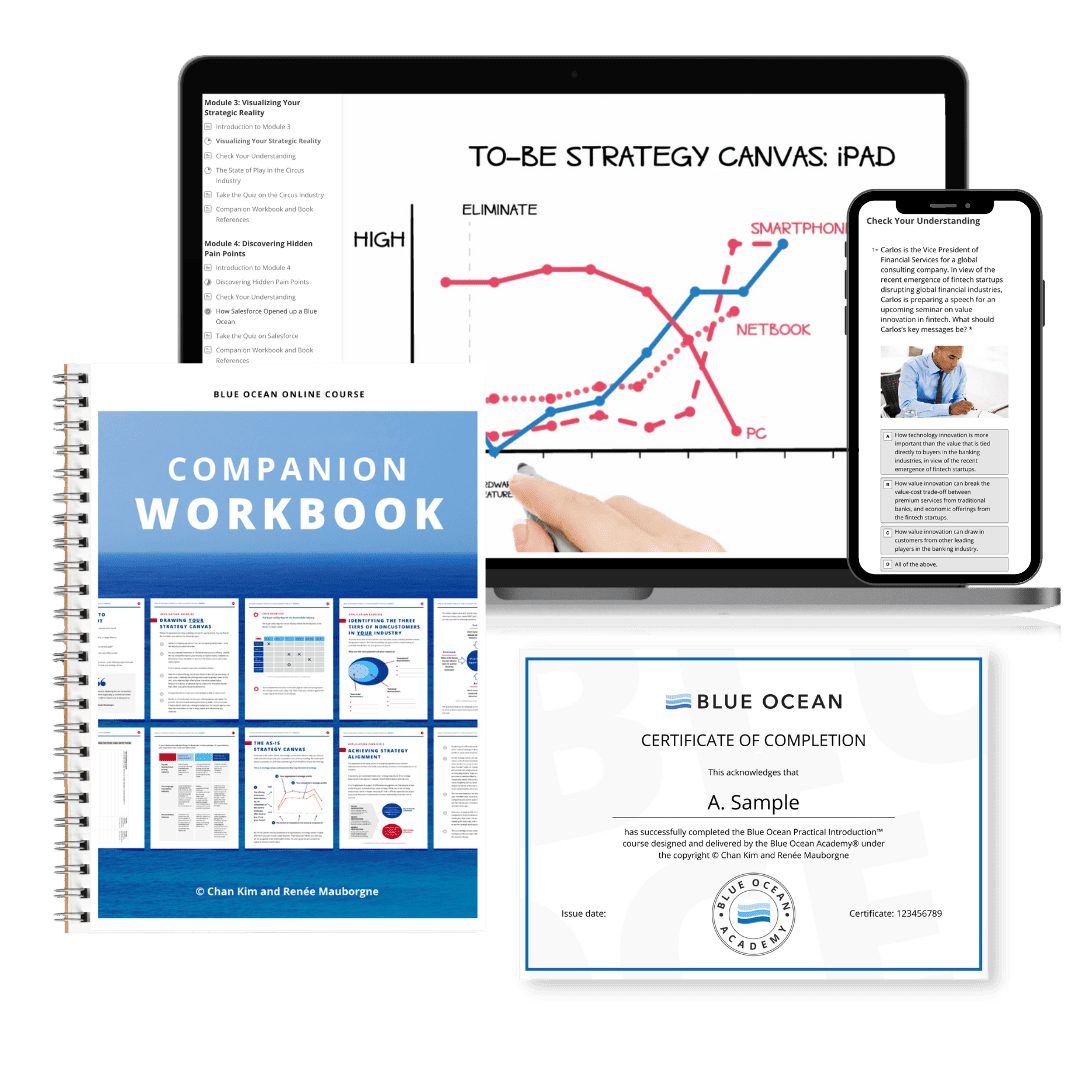Excerpts from Chan Kim & Renée Mauborgne’s Blue Ocean Strategy (2015) and Blue Ocean Shift (2017).
The four actions framework and the eliminate-reduce-raise-create (ERRC) grid are two analytical tools of blue ocean strategy to help you simultaneously pursue differentiation and low cost to achieve value innovation. In this blog, we’ll look at how the four actions framework and the ERRC grid work together, examine some examples, and provide you with a template you can use to start creating your blue ocean. Let’s dive in.
Four Actions Framework: an analytical tool to break the value-cost trade-off
The four actions framework is a blue ocean strategy analytical tool used to reconstruct buyer value elements in crafting a new value curve or strategic profile. The tool is developed by Chan Kim and Renée Mauborgne in their bestselling books Blue Ocean Strategy and Blue Ocean Shift.
See the four actions framework definition on the blue ocean tools page.
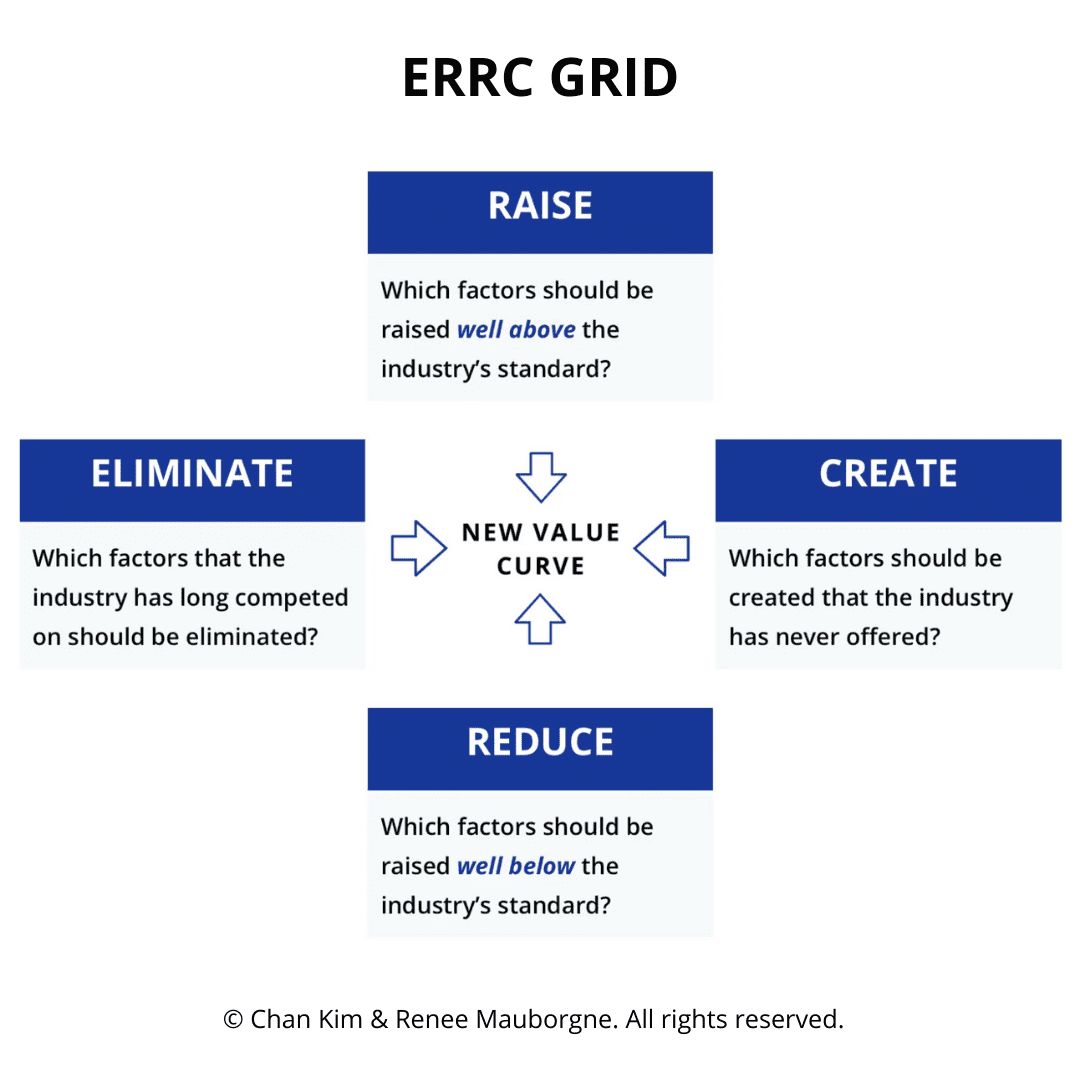
The four actions framework is built on four key questions that will help you challenge an industry’s strategic logic and business model to arrive at blue ocean moves that break the trade-off between differentiation and low cost.
Read next: Why Lowering Costs and Increasing Value Doesn’t Need to Be a Trade-Off
ELIMINATE: Which factors that the industry takes for granted should be eliminated?
This question forces you to consider eliminating factors that companies in your industry have long competed on. Often those factors are taken for granted even though they no longer have value or may even detract from value. Sometimes there is a fundamental change in what buyers value, but companies that are focused on benchmarking one another do not act on, or even perceive the change.
REDUCE: Which factors should be reduced well below the industry’s standard?
The second question pushes you to determine whether products or services have been overdesigned in the race to match and beat the competition. Here, organizations overserve customers, increasing their cost structure for no gain.
RAISE: Which factors should be raised well above the industry’s standard?
The third question pushes you to uncover and eliminate the compromises buyers are forced to make. These compromises are usually caused by an industry’s failure to see what buyers want more of some factors than the standard offering provides. But because the standard is the standard, no one thinks to challenge it.
CREATE: Which factors that the industry has never offered should be created?
The fourth question helps you to discover entirely new sources of value for buyers and to create new demand by converting once noncustomers into customers.
It is by pursuing the first two questions (of eliminating and reducing) that you gain insight into how to drop your cost structure vis-a-vis competitors.
The last two questions (of raising and creating) provide you with insight into how to lift buyer value and create new demand.
Collectively these four questions of the four actions framework allow you to systematically explore how you can reconstruct buyer value elements across alternative industries to offer buyers an entirely new experience, while simultaneously keeping your cost structure low.
ERRC GRID
To ensure that you pursue differentiation and low cost simultaneously, Chan Kim and Renée Mauborgne created the eliminate-reduce-raise-create (ERRC) grid, which complements the four actions framework.
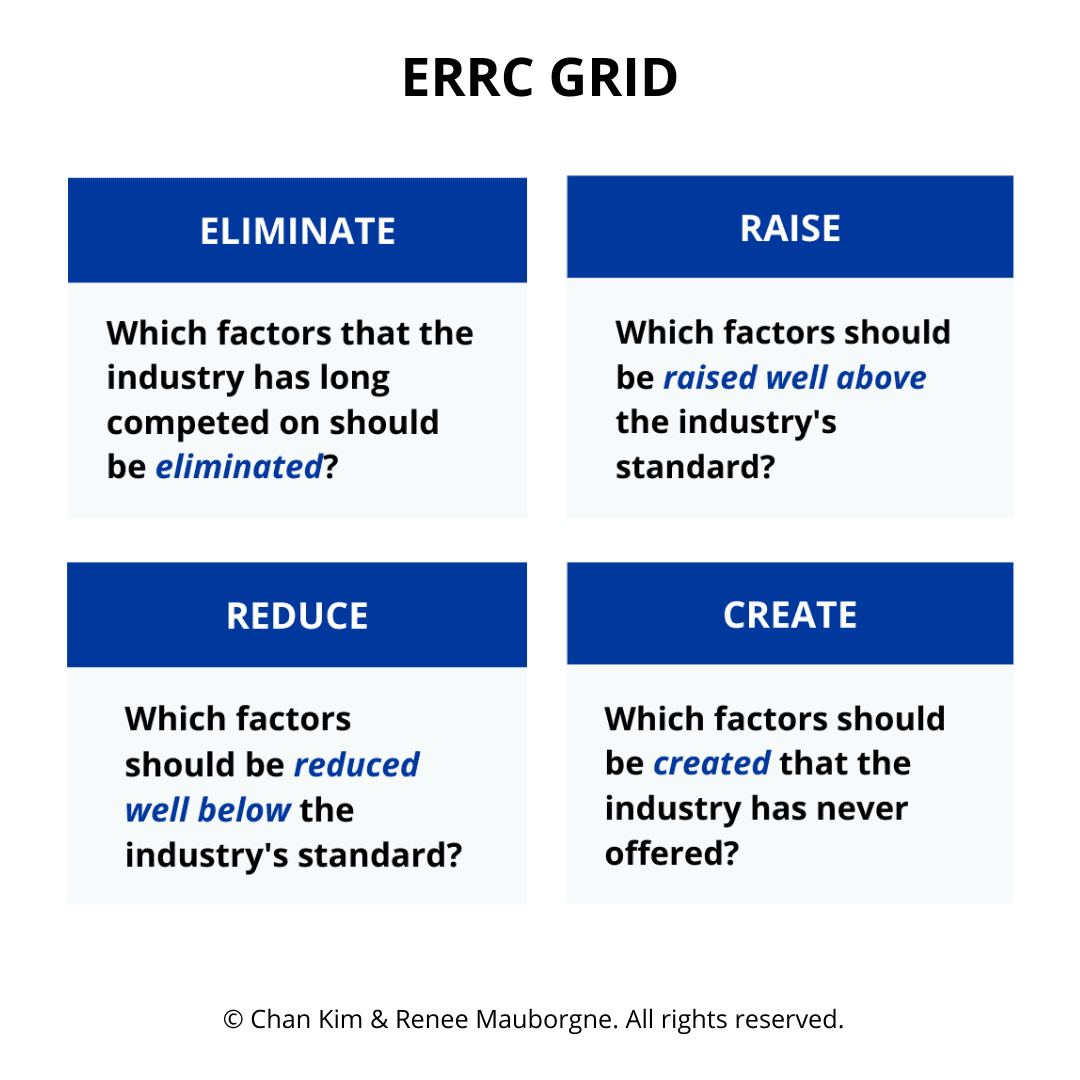
The ERRC grid pushes you not only to ask all four questions in the four actions framework but also to act on all four to create a new value curve.
Read the ERRC grid definition.
Read next: The Rising Importance of Value Innovation for Creating New Growth
The Four Actions Framework and Eliminate-Reduce-Raise-Create (ERRC) Grid Examples
Let’s look at two examples of how the four actions framework and ERRC grid work together to create a new value curve.
[yellow tail] – the classic example of blue ocean strategy
In the case of the U.S. wine industry, by thinking in terms of these four actions vis-a-vis the current industry logic and looking across alternatives and noncustomers, Casella Wines created [yellow tail], a wine whose strategic profile broke from the competition and created a blue ocean.
Read next: Customers First? How About Noncustomers First?
Instead of offering wine as wine, Casella created a social drink accessible to everyone: beer drinkers, cocktail drinkers, and other drinkers of nonwine beverages.
By looking at the alternatives of beer and ready-to-drink cocktails and thinking in terms of noncustomers, Casella Wines applied the Four Actions Framework and created three new factors in the US wine industry – easy drinking, easy to select, and fun and adventure – and eliminated or reduced the traditional factors of complexity and aging.
THE ERRC GRID OF [YELLOW TAIL]
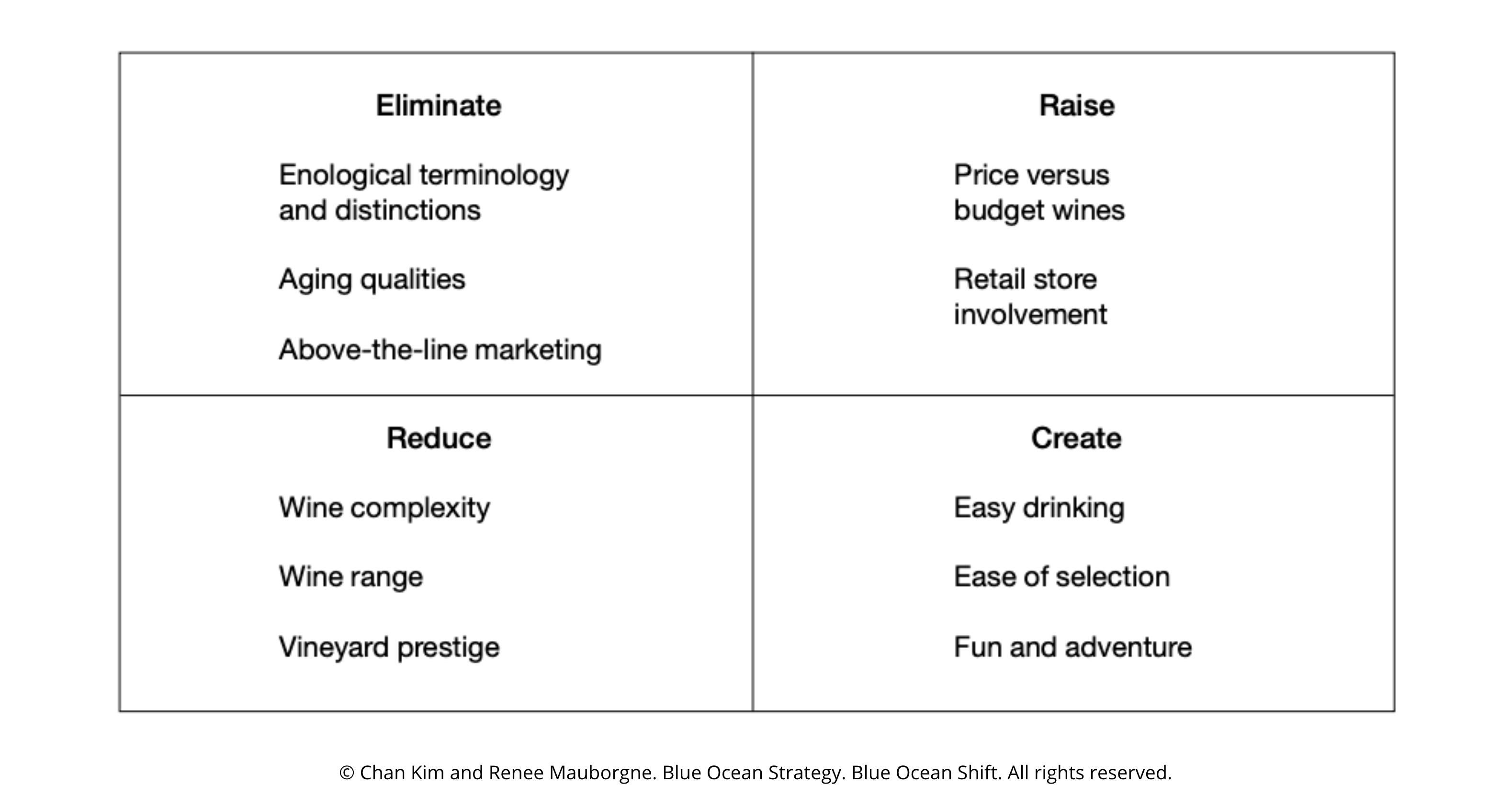
Casella Wines found that the mass of Americans rejected wine because its complicated taste was difficult to appreciate. Beer and ready-to-drink cocktails, for example, were much sweeter and easier to drink. Accordingly, [yellow tail] was a completely new combination of wine characteristics that produced an uncomplicated wine structure that was instantly appealing to the mass of alcohol drinkers.
By dramatically reducing the range of wine characteristics, [yellow tail] simplified a wine choice many consumers had traditionally seen as overwhelming and intimidating: bottles looked the same, labels were complicated with enological terminology and the range of choices was so extensive salesclerks had a hard time making recommendations.
In contrast, [yellow tail] produced only two wines at the start: Chardonnay and Shiraz. It removed all technical jargon from the bottles and created instead a striking, simple and nontraditional label. The simplicity of just two wines — a red and a white — helped streamline Casella Wines’ business model; it reduced stock-keeping units’ maximized stock turnover and lowered investment in the company’s warehouse inventory.
En route, Casella Wines was able to reconstruct buyer-value elements to offer an entirely new experience, while simultaneously keeping cost structures low, making the existing rules of competition irrelevant. [yellow tail] acted on the four actions framework to break away from its competition.
Check out [yellow tail]’s strategy canvas.
CitizenM – a blue ocean shift in an overcrowded industry
Now let’s look at the recent example in the hospitality industry.
“If there ever were a red ocean,” observes Michael Levie, co-founder of CitizenM Hotels, “the hotel industry would be it. It’s redder than red.”
The hotel industry competes on essentially the same set of factors, just more or less of them.
Despite all the factors the hotel industry competes on, it turned out that only three factors stood out as decisive in determining why frequent travelers traded up to five-star hotels over three stars: the feeling of luxury and beauty they experience; its more luxurious sleeping environment; and their prime location. As for those who choose a three-star hotel over a five-star, price jumped out as the most common factor, followed by one other: five-star hotels often felt too formal and pretentious.
Look at the ERRC grid example of citizenM hotels:
THE ERRC GRID OF CITIZENM
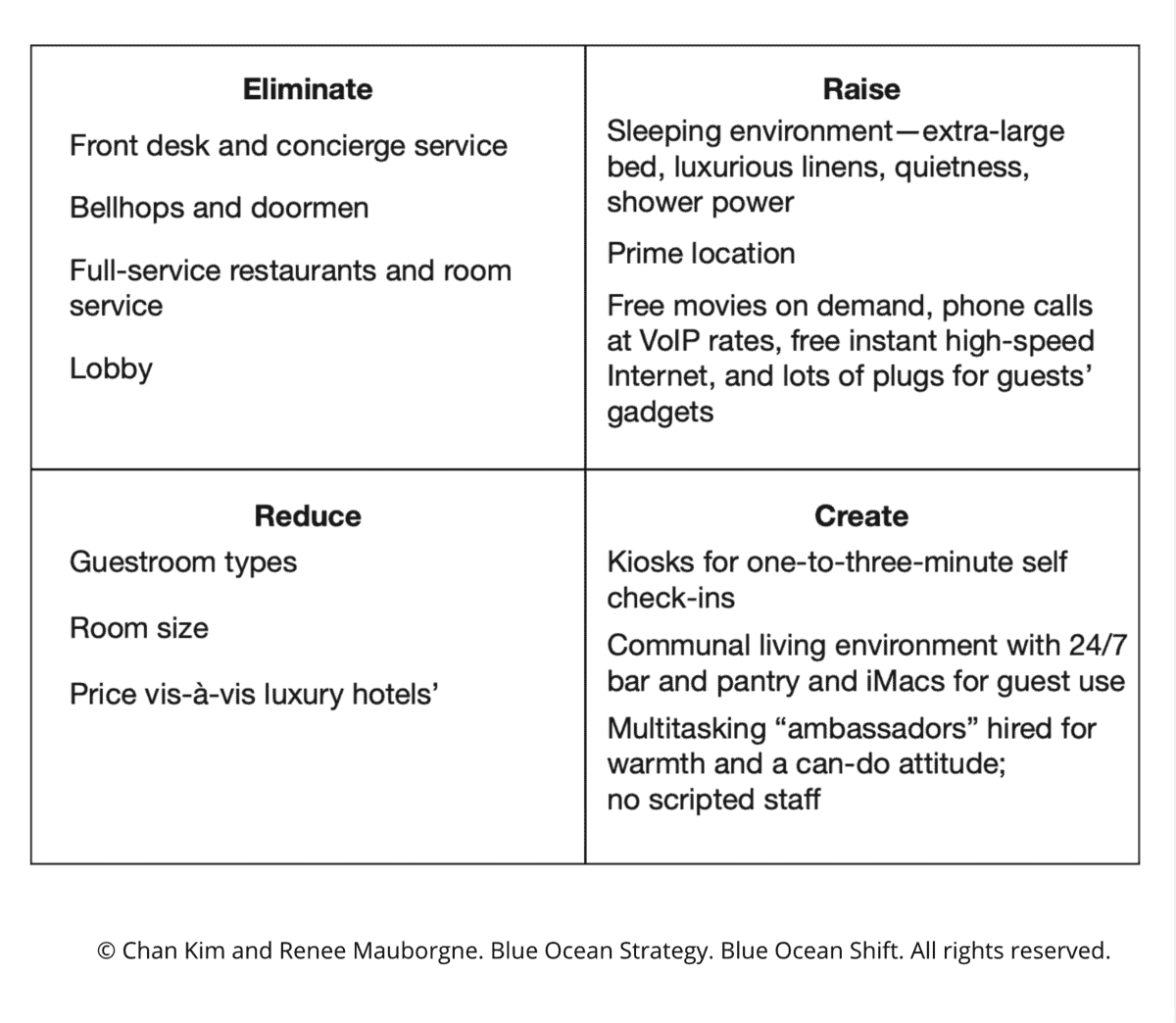
By gaining these insights, Chadha and Levie, co-founder and CEO of citizenM, identified which factors to eliminate, reduce, raise and create. For example, the customers of neither five-star nor three-star hotels saw the front desk, concierge service, bellhops, or doormen as bringing them much-added value. CitizenM saw these as factors they could eliminate.
Next, since the “mobile citizens” they were targeting aren’t the type of customer that spends much time in their room, they realised they could reduce room size – and cost – as this also meant more rooms per square foot of real estate space. And instead, to maintain a high level of comfort and luxury, they raised the quality of the sleeping environment with extra-large king beds, fine linens, good sound insulation, fluffy towels and amazing showers.
Finally, through these market insights, Chadha and Levie discovered that there were new kinds of value that they could create. They eliminated the front desk, replacing it with self-check-in kiosks allowing guests to check in with no lines. And in case help was needed, front desk staff were replaced with multi-tasking ‘ambassadors’ who could help with anything from giving directions to shaking a cocktail.
Check out the strategy canvas of citizenM hotels to see how its value curve diverges from the competition.
CitizenM created the new market space of affordable luxury hotels. CitizenM hotels earn the highest guest rankings in the hospitality industry. Yet, they’re priced to be affordable to three-start customers. The result is an average occupancy rate of 90 percent across its hotels – a whooping 80 percent higher than the industry average. As for costs, its total costs per room are roughly 40 percent lower than the average four-star hotel’s while its cost of staff is a staggering 50 percent lower than the industry’s.
When you apply the four actions framework to the strategy canvas of your industry, you get a revealing new look at old perceived truths. Look at what Apple’s iPhone eliminated, reduced, raised, and created to arrive at a new value curve on the strategy canvas that is clearly differentiated from the competition.
Or how Medellin, Colombia’s second-largest city, applied the four actions framework and acted on it for the Metrocable, the world’s first urban cable car system dedicated to public transport, at half the cost of a comparable railway system. It offered the people of Medellin a leap in value through differentiation and low cost.
Let’s shift our focus to applying the four actions framework and the ERRC grid to your scenario. The ERRC Grid template will come handy.
The ERRC Grid Template
The ERRC Grid template will help you to develop concrete and actionable blue ocean strategic options that break away from the competition and pursue both differentiation and low cost to value innovate. You should complete the ERRC grid for each path explored of the Six Paths Framework.
Read other blogs discussing the four actions framework and the eliminate-reduce-raise-create (ERRC) grid and learn how various organizations achieved differentiation and low cost to set themselves apart from the competition.
Why You Should Eliminate and Reduce to Find New Blue Oceans
Gogoro Electric Scooter: the Tesla of Electric Motorcycles?
How Go-Jek Is Creating a Blue Ocean in One of The World’s Most Congested Cities
